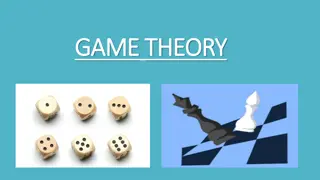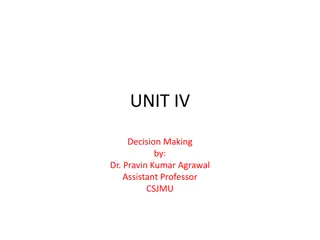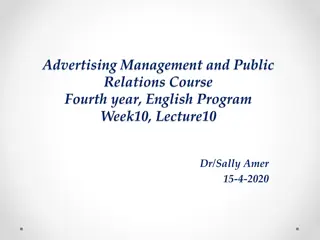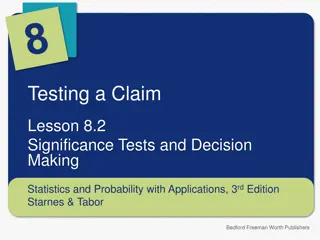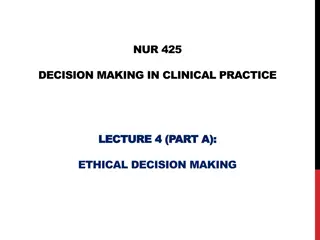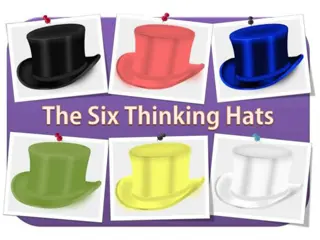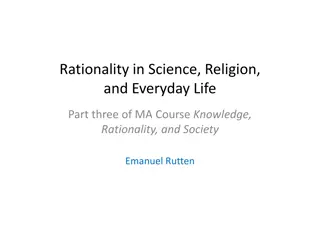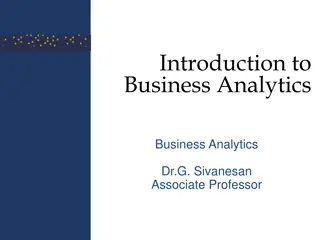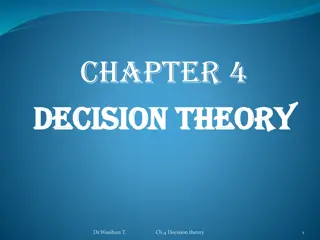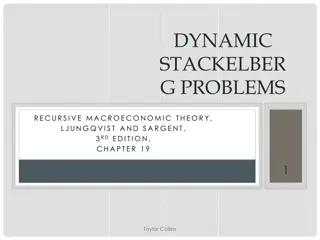Understanding Competitive Decision Making in Games
Practical problems often involve decision making in competitive scenarios with conflicting interests. Players have strategies, and outcomes result from their actions. Two-person zero-sum games are common examples. Key terms like players, strategies, pure strategy, and mixed strategy are essential in such games.
Download Presentation

Please find below an Image/Link to download the presentation.
The content on the website is provided AS IS for your information and personal use only. It may not be sold, licensed, or shared on other websites without obtaining consent from the author. Download presentation by click this link. If you encounter any issues during the download, it is possible that the publisher has removed the file from their server.
E N D
Presentation Transcript
INTRODUCTION Many practical problems require decision making in a competitive situation where there are two or more opposing parties with conflicting interests and where the action of one depends upon the one taken by the opponent.
EXAMPLES Candidates for an election Advertising and marketing campaigns by competing business firms Countries involved in military battles
PROPERTIES There are a finite number of competitors called players Each player has a finite number of strategies available to him A play of the game takes place when each player employs his strategy Every game results in an outcome
TWO-PERSON ZERO- SUM GAMES When there are two competitors playing a game, it is called a two-person game . Games having the zero-sum character that the algebraic sum of gains and losses of all players is zero are called zero-sum games.
PLAYER The competitors in the game are known as players. A player may be individual or group of individuals, or an organization.
STRATEGY A strategy for a player is defined as a set of rules or alternative courses of action available to him in advance. It has two types Pure strategy Mixed strategy
PURE STRATEGY If the players select the same strategy each time, then it is referred to as pure-strategy. In this case each player knows exactly what the other player is going to do, the objective of the players is to maximize gains or to minimize losses.
MIXED STRATEGY When the players use a combination of strategies and each player always kept guessing as to which course of action is to be selected by the other player at a particular occasion then this is known as mixed strategy. Thus, there is a probabilistic situation and objective of the player is to maximize expected gains or to minimize losses.
OPTIMUM STRATEGY A course of action or play which puts the player in the most preferred position, irrespective of the strategy of his competitors, is called an optimum strategy.
VALUE OF THE GAME It is the expected payoff of play when all the players of the game follow their optimum strategies.
PAYOFF MATRIX When the players select their particular strategies, the payoffs can be represented in the form of a matrix called the payoff matrix.
Let player A have m strategies A1, A2,, Am and player B have n strategies B1,B2 ,Bn. Here, it is assumed that each player has his choices from amongst the pure strategies. Also it is assumed that player A is always the gainer and player B is always the loser. That is, all payoffs are assumed in terms of player A.
Let aijbe the payoff which player A gains from player B if player A chooses strategy Ai and player B chooses strategy Bj. Then the payoff matrix to play A is: Player B B2 a12 a22 . . . am2 B1 a11 a21 . . . am1 Bn a1n a2n . . . amn A1 A2 Player A . . . Am
Consider a two-person coin tossing game. Each player tosses an unbiased coin simultaneously. Player B pays Rs. 7 to A if {H,H} occurs and Rs.4 if {T,T} occurs; otherwise player A pays Rs.3 to B. This two-person game is a zero sum game since the winnings of one player are the losses for the other. Each player has his choices from amongst two pure strategies H and T. A s payoff matrix may be displayed as below : Player B H T 7 -3 Player A H T -3 4
PREPARED BY D.PHILOMINE JEEVITHA DEPT OF MATHEMATICS ST.JOSEPHS COLLEGE TRICHY






